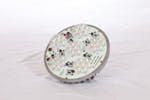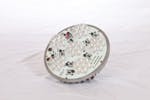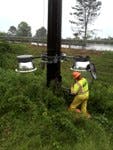This article was published in the June 2012 issue of LEDs Magazine.
View the Table of Contents and download the PDF file of the complete June 2012 issue, or view the E-zine version in your browser.
+++++
We routinely cover case studies of LEDs used in outdoor, street- and area-lighting applications where solid-state lighting (SSL) is delivering significant savings in both energy and maintenance costs. But repeatedly at conferences the prevailing wisdom among speakers has been that the high lumen output required in high-mast applications would require SSL fixtures that cost far more than metal-halide (MH) or high-pressure sodium (HPS) sources – an even greater cost differential than is the case with normal street lights. Presumably the high cost can stretch the payback beyond what municipalities or transportation departments are comfortable with. The Maine Department of Transportation (MaineDOT), however, is testing LED-based lights in a high-mast retrofit and the results are promising.
The applications for high-mast lights include installations at transportation terminals, other large, outdoor maintenance or storage yards, and specialty roadway applications. The aforementioned freeway interchange installations are probably the most common roadway application, although you will find some high-mast lights within municipalities in busy areas.
In street-light installations, the lighting designer normally specifies a rectangular beam distribution or pattern that directs the lumens precisely and eliminates light spill. The pattern is designed to evenly illuminate the roadway with maximum spacing between poles. High-mast applications rely on more of a circular or square pattern and are designed to distribute light evenly over a maximum-sized radius or area.
If you look at legacy lights installed in North America, you can generalize about the two disparate applications in terms of energy usage. Municipalities typically install 250-400W HPS lights individually on a pole in street-light applications. High-mast installations regularly gang 2, 4, 6 or 8 1000W HPS fixtures spaced evenly around a single pole.
Potential savings
Clearly there is potential for savings in such high-mast applications. Including the ballast, a 1000W HPS light actually consumes as much as 1200W. LEDs could certainly cut that energy usage. Plus consider the potential maintenance savings. About high-mast light owners, Jeffrey Newman, president of Global Tech LED, said “They have been replacing lamps once per year.”
Global Tech manufactures LED modules designed for use in high-mast retrofit applications. The modules include six clusters of seven LEDs for a total of 42 Philips Lumileds LEDs per module (Fig. 1). Global Tech has developed customized lenses that cover each LED cluster to control the beam pattern. Depending on the application, as many as four of the Global Tech modules might be used to replace a single high-output HID lamp.
The LED approach saves 600W. Based on a burn time of 12 hours per night, the savings amount to 2628 kWh per year. At a rate of $0.12 per kWh, that electricity saving equates to around $315 per year. The price a municipality would pay for the retrofit would depend on distributor pricing, but Newman said that MaineDOT is paying in the range of $1200 to $1300 per kit including credits supplied by the state. So the payback is in the four-year range before you consider maintenance costs, and perhaps a lower-power LED implementation.
According to Newman, the LED project in Maine is about more than savings and payback and is focused on keeping the lights on. He said, “They were shutting the lights off at 11 pm at night because of the expense.” The LED retrofit will allow the lights to burn all night, although the long-term plan may also entail dimming the lights late at night.
Maine Interstate 295
Ron Cote with MaineDOT said that he was doubtful that an LED-based product could serve in the high-mast application when Global Tech first approached the state. But after seeing the modular approach, MaineDOT retrofitted one high-mast pole with the Global Tech modules eight months ago. Cote reports that the retrofitted fixtures on the pole have been problem free.
Once installed Cote said that the LEDs provide 1 fc at ground level out to a distance of 200-300 ft. He said, “Up until now, there hasn’t been an LED fixture that could touch the light distribution of HPS.” But Cote said that the installed LEDs are providing comparable performance.
After testing the one pole, MaineDOT is retrofitting eight additional poles at two freeway interchanges. Cote reports that the retrofit process is relatively simple. Typically high-mast lights are mounted in such a way that cables can be used to lower the fixtures to ground level as opposed to requiring a bucket truck for service (Fig. 2). Cote said it typically takes about 20 minutes to lower a set of lights and another 20 minutes to raise the fixtures back up the pole once service is finished. He said it also takes workers about 20 minutes per fixture to install the retrofit.
MaineDOT is able to afford to burn the LED lights all night. Cote said that the SSL retrofit is delivering about 66% in energy savings. The energy cost per freeway interchange has dropped from $800 to $266 per month.
The lights are also superior in terms of quality. Fig. 3. shows one of the Maine LED high-mast lights. Cote said the broad-spectrum light and 5000K CCT provide better visibility. Before and after photos weren’t available for the Maine installation. But Fig. 4 shows LED and HPS high-mast lights from a Global Tech project at a Florida shipping container terminal.
The energy-conservation-oriented Efficiency Maine organization also commented on the quality of the SSL retrofit. “I went by the Waterville exits this morning on the way in,” said Michael Watson, project engineer at Efficiency Maine. “The Kennedy Memorial Drive exit is done, all four towers have the LED fixtures and it looks great. They also had one done at the Main Street exit and what a difference it makes compared to the HPS fixtures. The LEDs really light it up nice.”
Controls and dimming
Looking forward, Cote said that MaineDOT is contemplating a retrofit of 108 additional poles – the entire high-mast inventory along I-295. Moreover the department may consider dimming the lights for five to six hours each night to further reduce energy consumption.
Newman said Global Tech has also developed a wireless control network that can optionally be installed in the retrofit modules. For now, MaineDOT is not installing modules with wireless support.
Cote said that MaineDOT will likely test dimming at a single interchange in the next phase of the project. The department will then seek input from the public and other interested parties on the light levels.
The savings potential of LEDs on the Maine interstate system is significant. Cote said that the state spends $750,000 annually on interstate highway lighting. Not all of the lighting is high-mast. But Cote thinks the state could definitely save a third of the total just through a move to LEDs on high-mast poles.
MaineDOT also expects to realize significant maintenance savings, although they haven’t projected a figure. Cote said, however, that they were expecting 50,000 hours of life from the LEDs. That would certainly curtail the maintenance cycles for replacing HPS lamps.









